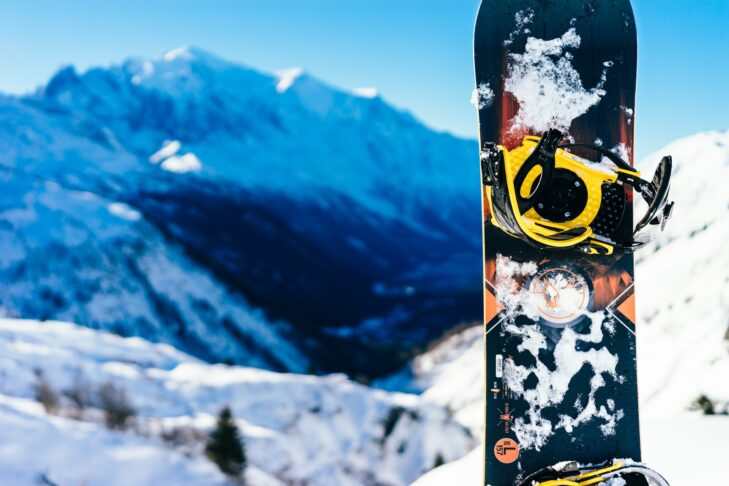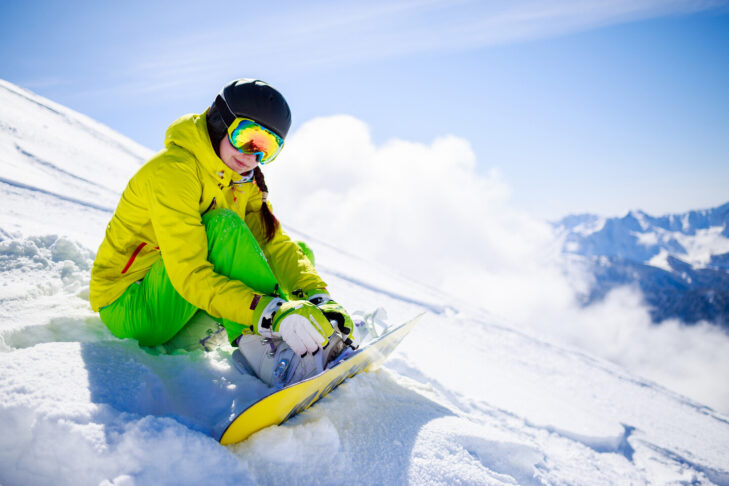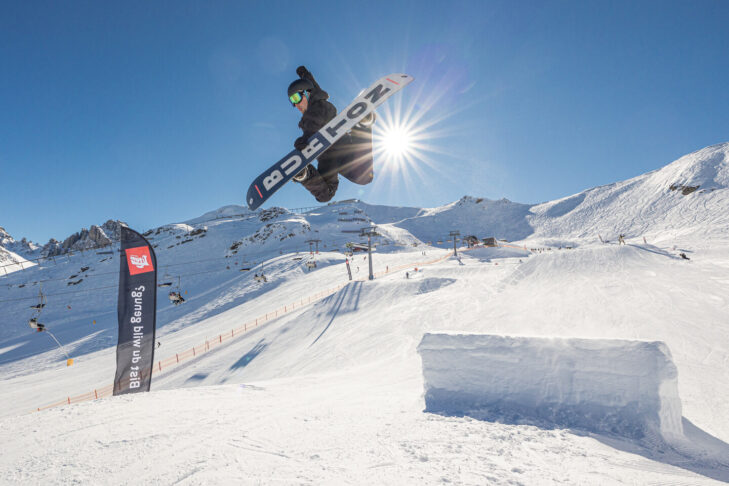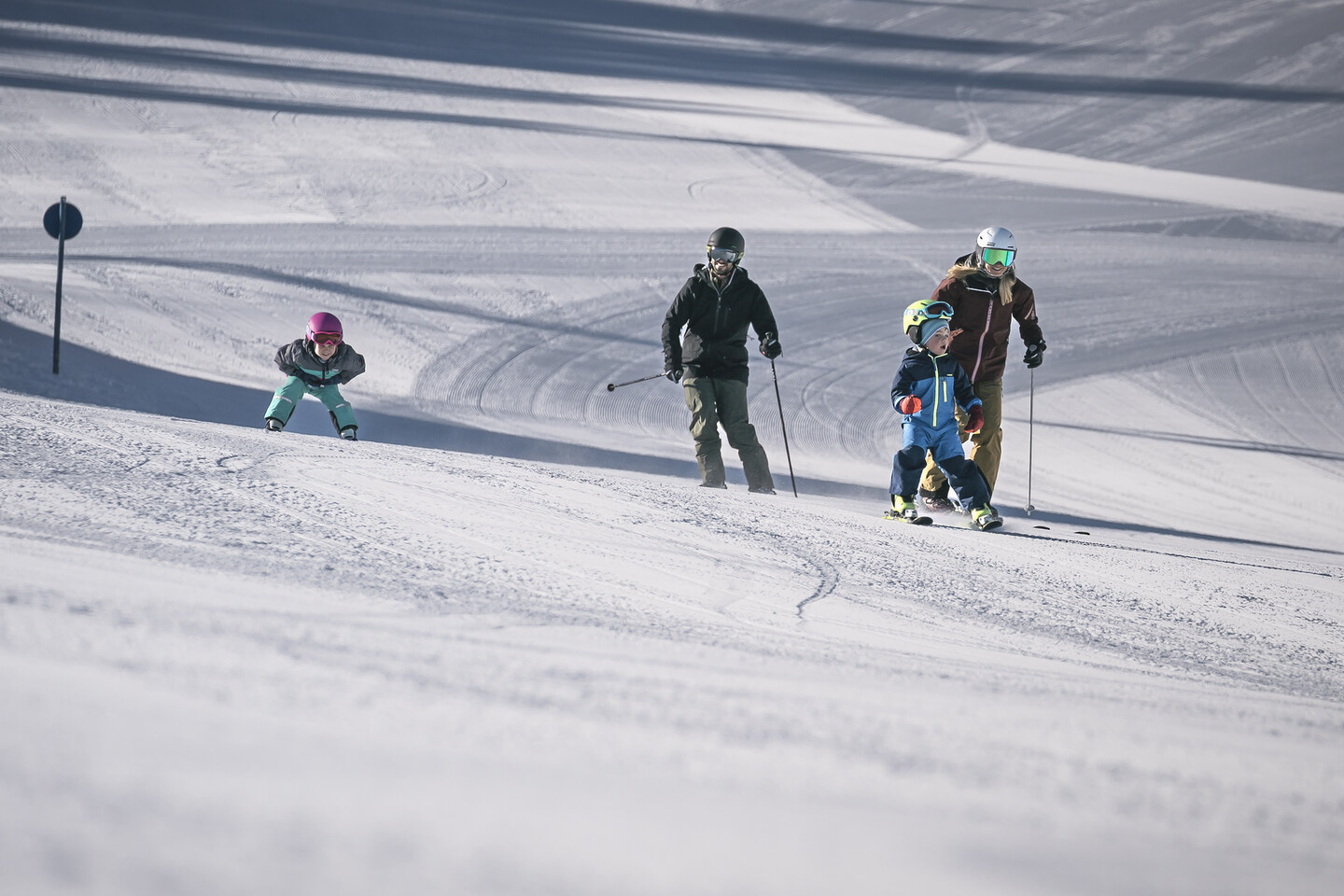Carve on perfectly groomed slopes, dive deep into the powder off-piste or take off on the kicker and conjure up tricks in the blue sky. With the perfect snowboard set-up, winter sports enthusiasts can experience exactly these moments in the mountains. In addition to the ideal board and the right boots, this also includes the right snowboard bindings. SnowTrex knows what is important when choosing snowboard material and why the binding ensures safety and control in the snow.
What makes good snowboard bindings
The construction of a binding as part of the snowboard equipment requires three essential elements: the baseplate, the highback and the straps. As the name suggests, the baseplate, also known as the chassis, is the foundation of every snowboard binding, as it is bolted to the board. The plates themselves have to be very stable, as they have to transfer the power of the winter sports enthusiast to the board as well as absorb shocks. They are therefore made of either hard plastic or aluminium. The footbed is also integrated into the baseplate. It consists of soft foam, which often has air cushions incorporated into it. The footbed thus forms the “shock absorber” of a binding, as the sole of the snowboard boot rests directly on it.
The highback is the vertical plate that rests against the back of the calf, stabilises the lower leg in turns and thus transfers the power to the board. Like the entire snowboard binding, this part is usually made of plastic. The height and flex level of highbacks can be adapted to the riding style or terrain. Shorter and softer highbacks allow more freedom of movement and are therefore more suitable for freestylers or snowboard beginners. High and stiff versions, on the other hand, give winter sports enthusiasts more control and precision, which makes them attractive for freeriders and experienced boarders. The connection between the baseplate and highback is formed by the heel cup, another plastic part that holds the heel in the back of the snowboard binding.
The straps close off the entire binding system at the front. Most models have two straps to secure the snowboard boots: the toe strap at the toe and the ankle strap over the instep. These hold the boot in the binding and are padded for comfort. The straps are fastened with buckles that can be opened and closed quickly using a ratchet system. In entry-level bindings, the buckles are often made of plastic, while in higher-quality bindings they are made of aluminium or now also magnesium.
All snowboard bindings have their “type”
Since snowboarding gradually became popular in ski resorts around the world in the 1970s, not only the boards themselves but also the equipment required have developed considerably. It is therefore not surprising that today there are several types of snowboard bindings, which once again present winter sports enthusiasts with a choice. The best known and still the most widespread “type” is the soft binding. After stepping into the snowboard boot, it is stabilised in the calf area by a highback. The foot is then secured by two straps at the toes and instep. These bindings are usually made of plastic or aluminium and can be adapted to the individual riding style using interchangeable highbacks and footbeds.
Flow, cinch, step-in and plates – this is the binding family
Flow bindings are very similar in design to classic soft bindings, but differ in important ways. For example, although the foot is also fixed at the front with two straps, these are connected to each other and cannot be opened. The highback, on the other hand, can be lowered backwards and, when the winter sports enthusiast is standing with the snowboard boot in the binding, can be folded up again and secured with a buckle. As you can slip your foot into the binding as quickly as into a slipper, this model is also known as a speed-entry binding or snowboard binding with quick entry. The cinch binding even combines the advantages of the soft and flow bindings. This snowboard binding with quick release is also equipped with two fixed straps, but these can be opened and closed with ratchets. The highback is connected to the baseplate at the calf by two ropes. This means that the highback can simply be folded away for quick entry and exit.
In this video, experts explain which snowboard bindings are available on the market and how winter sports enthusiasts can find the right model for them:
Please also note that by using our services and integrating the YouTube API Services, the YouTube Terms of Service and the YouTube API Services Terms apply and your use of our website is deemed to be acceptance of these terms.
The manufacturers of step-in bindings pursue a completely different concept. Not only are the two straps at the front omitted here. Winter sports enthusiasts also need special snowboard boots to get on. These are equipped with two metal pins on the right and left at the tip of the boot. To secure the foot in the binding, these two pins engage in a spring on the baseplate, from which they can be released at the end with the press of a finger. Like the other models, the step-in bindings also have a calf-high highback at the back for stabilisation. Only the plate bindings do without this shaft completely. However, these are almost exclusively intended for mounting on raceboards that are ridden with hard boots, which are very similar to ski boots. To fix the boot in place, the heel is pushed into a rigid metal bracket at the back, while a flexible metal bracket with a buckle is folded over the toe at the front.
The right snowboard binding for every style
Snowboard bindings are not only very variable in terms of design. Even when it comes to the style of the rider or the terrain in which the board is to be ridden, winter sports enthusiasts can customise the material to suit their needs. If you want to buy a snowboard binding, you have to invest quite a bit for the right quality. Classic and affordable soft bindings are available from around 60 pounds. After that, the price range opens up considerably. Equipment for professionals, some of which is not made from plastic but from lightweight materials such as carbon or fibreglass, can cost up to 350 pounds.
A brand new snowboard binding for beginners is sometimes available for bargain hunters for less than 90pounds . Overall, however, you should always expect to pay at least three figures in this segment. You can’t go wrong with an all-mountain binding. These are real “all-rounders”. The fact that snowboards with these bindings can be ridden on the piste as well as in deep snow or in the snow park is due to the medium flex level of the material. The flex is the most important value for a snowboard binding, determining the terrain for which the various models are suitable. The scale ranges from 1 to 10, with the range between 1 and 4 being described as “soft”. This is ideal for freestylers, as the binding can absorb impacts and shocks well, for example when landing jumps.
How snowboarders find the right binding size
Bindings with a “medium” flex of 5 or 6, on the other hand, are versatile and can be ridden on any terrain. Professional snowboarders who love speed on the piste or freeriders who want to have maximum control over their board in deep snow always opt for material that is categorised as “hard”, i.e. has a flex between 7 and 10. When choosing snowboard bindings, it is also important to ask yourself the question of size. We have created a size chart to help you find the right snowboard binding:
| Binding Size | Men's Shoe Sizes (EU) | Women's Shoe Sizes (EU) |
|---|---|---|
| S | 37 to 40 | 34.5 to 37 |
| M | 40 to 44 | 38 to 40 |
| L | 44.5 and up | 40.5 and up |
Like the other models, freestyle snowboard bindings are of course available in all sizes. They usually have a slanted footbed, a soft flex due to the cushioning effect and are also relatively lightweight due to their short, asymmetrical highback. Freeride bindings, on the other hand, are a completely different story. You have to apply a lot of force to get boards with this material to turn. That’s why they are only for professionals who want to be really fast on the piste or feel at home in deep snow. In both cases, maximum control over the board is required. These bindings offer this thanks to their high highbacks and the use of stiff components such as carbon or aluminium.
So the binding also fits on the board
Snowboards and the different types of bindings often look similar, but in most cases they are very different. To mount a snowboard binding, it is screwed onto the board with the baseplate. Of course, this requires the corresponding holes (inserts) and these are arranged very differently depending on the model. In other words: Not every binding fits every snowboard! The hole system chosen by most manufacturers today is the 2×4 system. The numbers stand for the distance between the individual holes. So 2 cm (distance in length) and 4 cm (distance in width). The boards therefore have twelve holes on each foot, i.e. a total of 24 per board.
The two experts show how snowboarders can install a binding in their board themselves in the following video:
Please also note that by using our services and integrating the YouTube API Services, the YouTube Terms of Service and the YouTube API Services Terms apply and your use of our website is deemed to be acceptance of these terms.
The 4×4 system also works according to the same principle, but with fewer inserts, with spacing of 4 cm in all directions. This reduces the number of holes per foot to a total of six. Nevertheless, the system is compatible with all 2×4 bindings of all brands – except for one. And that is Burton. The pioneers in snowboard construction have developed two completely unique insert systems for their boards that only work with their bindings.
Burton bindings only fit Burton snowboards
The whole thing is called “Burton 3D” and as the name suggests, the holes are not arranged in a square shape, but in a triangular shape. A round washer with three holes is therefore required for assembly. This is inserted into the baseplate of a Burton binding and then screwed to the board. However, this system is now only found on older Burton snowboards and newer models for children and is therefore no longer so widespread. This is also due to the fact that the manufacturer has now launched “The Channel” system on the market. What makes it special are two long, narrow recesses, one for each foot, in the centre of the board. Two small slides with a metal pin can be inserted into these, which serve as a holder for the binding. This allows winter sports enthusiasts to easily slide the snowboard binding over the board and adjust the position of the feet with millimetre precision.
FAQ about snowboard bindings
What different types of snowboard bindings are there?
There are a total of five different types of snowboard bindings. The most common are the so-called soft bindings with two flexible buckles on the back of the foot and on the toes to secure the snowboard boots. There are also flow bindings, where the buckles (straps) are fixed but the shaft in the calf area (highback) can be folded down. Cinch bindings work in a similar way. Step-in bindings do away with straps altogether and instead the snowboard boots are fixed in the binding with two metal pins. Plate bindings, on the other hand, are only compatible with hard boots, which are very similar to ski boots.
Can any binding be fitted to any snowboard?
No. Various hole systems have now been developed for snowboards into which the bindings can be screwed. The so-called 2×4 and 4×4 systems are particularly popular. Here, the snowboard bindings are mounted in four square holes (inserts). Burton has also developed its own systems such as the “Burton 3D”, in which the inserts are arranged in a triangular shape. With “The Channel”, the snowboard brand also offers a system that completely dispenses with screws and is instead equipped with a rail system for fastening the bindings.
Are there snowboard bindings that are better suited to beginners?
Bindings with a soft flex, i.e. a value between 1 and 4, are mainly suitable for beginners. The advantage of these all-mountain models is that relatively little force has to be applied to the board and the material is more forgiving of riding errors. These snowboard bindings are also suitable for beginners in any terrain, whether on the piste, in deep snow or in the snow park.
How much do snowboard bindings cost?
The price range for new snowboard bindings is between 60 and 350 pounds. The price range for new snowboard bindings is between 60 and 350 pounds. Bargain hunters can often buy favourable models for less than 90 pounds, depending on the offer. High-quality bindings made of carbon or aluminium, on the other hand, can cost up to 350 pounds.





